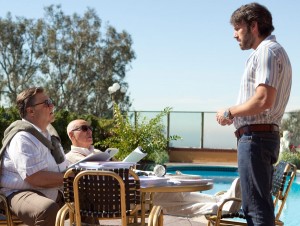Argo impresses with strong cast, director
When professionals have inhabited a certain role in the film industry for decades, they often find the need to try their hand at something more challenging. Frequently, a producer or visual effects designer will attempt a somewhat smooth transition into directing his or her own projects.
Occasionally though, an actor or actress will make the more drastic jump from performance in front of the camera to supervision behind the frame. Renowned actors like Woody Allen and Clint Eastwood have found tremendous success in direction, leading to the production of multiple classic movies and Oscar hardware.

Hollywood heavyweights· John Goodman (left), Alan Arkin and Ben Affleck star in Argo, a film about the Iranian hostage crisis. This versatile cast allows the film to fluctuate between the hilarious and the dramatic. – Photo by Claire Fogler, courtesy of Warner Bros. Pictures
More recently, commercial actors like George Clooney and Ben Affleck have chosen a seat in the director’s chair, in addition to accepting a leading role. In Argo, the two creatives unify their storytelling talents, with Clooney as producer and Affleck as star and director. Clooney’s production talents are certainly felt, but Affleck commands this film from start to finish.
The story behind Argo is so ridiculous and partly comical at first glance, it’s hard to imagine that screenwriter Chris Terrio based it on real CIA operations. During the 1979 Iranian Revolution, Iranian protestors seized the U.S. embassy, taking 66 Americans hostage. But there’s a lesser-known side of the story: Before the revolutionaries invaded the safe haven, six workers managed to escape out a back exit. Taking refuge in the home of a Canadian ambassador, the six Americans waited months for the U.S. government to help them escape the country safely. The special forces unit of the CIA faced a difficult task: to return the hostages safely to U.S. soil all without attracting notice from revolutionary forces.
To solve this conundrum, specialist Tony Mendez (Ben Affleck) constructed the plan of having the stranded Americans pose as a Canadian film crew scouting locations. In order to “fake” the authenticity of his film, Mendez travelled to Hollywood and developed a science-fiction spectacular. Thrilling action and surprisingly light comedy ensue as the audience remains on the edge of their collective seat, desperately hoping the six refugees survive.
After an excellent directing debut in Gone Baby Gone and an equally successful directing and acting in the action drama, The Town, Affleck asserted himself as not only one of the best actors-turned-director, but an elite filmmaker period. Whereas his first two films were set in Boston, Affleck’s hometown, the setting of Argo is much more complex, jumping between Iran, Washington, D.C. and Hollywood. Affleck’s lack of familiarity with location is barely noticed: The stories in each location feel perfectly genuine for the time and place. Affleck works with the strongly connected nature of Terrio’s script, which seamlessly moves between stories. In addition, the film mirrors the social characteristics of rebellion and protest of the ’70s through vintage costumes and a unique visual style.
But Argo succeeds mainly through excellent performances from the entire cast.
Amazingly, Affleck manages to illuminate the best traits of each actor’s capabilities. Bryan Cranston, who plays CIA head Jack O’Donnell, moves across the entire spectrum of emotional as the film progresses to its conclusion. In early scenes, O’Donnell is humorously inept at his responsibilities; however, by the climatic ending, he’s forceful and defiant.
Affleck and Terrio also contrast the dramatic portrayals of Mendez and O’Donnell with the hilarious inclusion of John Chambers (John Goodman) and Lester Siegel (Alan Arkin), two Hollywood executives who agree to help Mendez create the phony film.
Both Goodman and Arkin play their characters perfectly. Mendez, as well as the audience, journeys to Hollywood with prejudiced preconceptions of these eccentric executives — and Chambers and Siegel are everything Mendez could have imagined and more. Siegel comes off as demanding and cocky, lavishly adorned with fancy clothes, jewelry and a gold-painted car. And Terrio gives Arkin several excellent lines of dialogue that one can’t help but continuously quote after the film ends. Arkin injects Siegel with grumpy outer characteristics laid over a caring, honest core. With his strong portrayal in Argo, Arkin is sure to be a contender in the best supporting actor award category.
As this is Affleck’s film, it would be remiss to not analyze his take on the protagonist Mendez. Affleck’s portrayal of Mendez effectively guides the film through its broad plot and intellectual themes without demanding the complete attention of the audience. Affleck’s performance is understated, but not at all underwhelming. The combination of these four actors (Affleck, Cranston, Goodman and Arkin) defines Argo and makes it the excellent film that it is.
With a story as unbelievable as the one in Argo, the line between parodying history and paying homage to past events is so thin and permeable that finding the best format for a film can be difficult. Despite this daunting task, Affleck mixes comedy and intense drama in a way few films dare nowadays; even in tight emotional moments illustrating the horror of the revolution, Affleck somehow engineers feelings of laughter. The impeccable balance of these two emotions is a testament to Terrio’s outstanding adapted screenplay and Affleck’s skill as a director.
It’s quite difficult to find any flaws with Argo. Aesthetically, some visual effects might be poorly animated and slightly jarring, and the emotional and political impact of themes are not quite as powerful as one might hope. Yet, these are minor gripes in a film that is perhaps the best this year so far and will definitely be discussed come awards season.

Comments are closed.